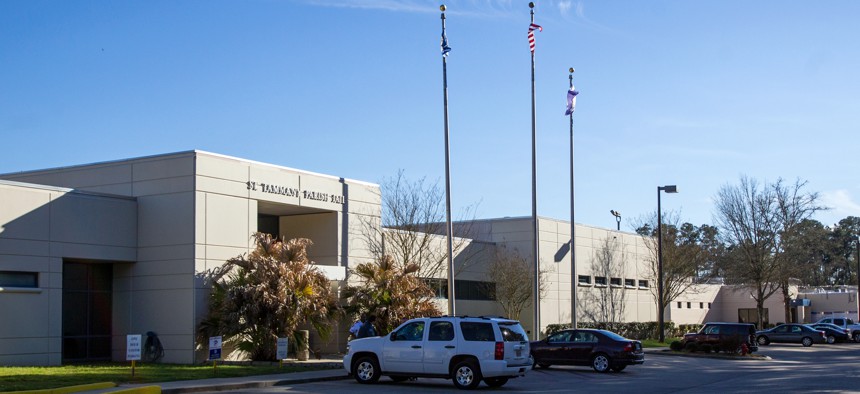The Human Cost of Missing Data in Prisons

The St. Tammany Parish Jail, which houses state prisoners in Louisiana, as do many local detention centers. AP Photo via The Advocate
COMMENTARY | Nowhere is good information about operations more critical than in prisons and jails. But too often states simply lack the kind of data that holds officials accountable.
Across the country, the nation’s prisons and jails face major challenges—including understaffing, outdated facilities and insufficient medical care—that can foster violence that jeopardizes both inmates and staff. Many states are trying to tackle these problems, but they face a basic impediment: A lack of data that leaves decision-makers stymied in reaching good policy decisions.
“It’s a grave problem,” say Adam Gelb, a nationally-recognized expert about incarceration and president of the Council on Criminal Justice. “In most states we don’t have anywhere near the bandwidth of information to assess how well or poorly prisons are fulfilling their mandates.”
Just last month, Tennessee’s Division of State Audit issued a critical report about the state’s department of corrections. The report indicates that corrections leaders and the legislature simply don’t have the data necessary to effectively manage their prisons.
Perhaps the most flagrant example of questionable data is Tennessee’s measures of individual facilities’ performance. “Each year,” says Vince Finamore, audit manager of that report, “the department (of corrections) tells the legislature these scores look great. Many are rated at over 95%.”
But the state comes up with those averages by looking at a wide swath of data points and averaging them all as equals. That means the grades give equal weight to keeping kitchen and laundry water heaters in good maintenance as it does to problems in sufficiently monitoring the mental health of prisoners. A prison with a number of serious problems identified by the corrections agency could end up with a high performance score because it racked up good scores on less important categories.
As the audit reports, “These scores do not differentiate between ‘critical’ or ‘other’ findings and do not stress mission critical areas that may directly impact the safety and security of inmates, staff and the general public.”
One reason this is such a problem is that corrections department leaders use the data they collect to decide how many staff members they need for a particular prison—one of the most consequential decisions over which policy makers have some control.
There’s much more in the audit that raises concerns, including insufficient reporting of inmate deaths and serious incidents into a central database. Near the top of the list is a lack of consistency in how the data is validated, and as such “managers may be getting misinformation, which can lead to larger problems” says Finamore.
The Tennessee Department of Corrections accepted the auditor’s findings, explaining the reasons for some of the problems, but also conceding that the agency needs to quickly address the record keeping problems.
One of the most significant causes of violence in prisons is overcrowding and understaffing. Yet, in Louisiana, inadequate systems for monitoring when prisoners should be released have too often resulted in inmates serving more time behind bars than they are actually required to under the law. Corrections officials have acknowledged this problem, estimating in 2019 it costs the state $2.8 million a year.
According to a 2017 Louisiana audit, the state Department of Corrections not only had a problem with calculating when prisoners should be released, but needed to improve how it manages “offender data, including better tracking of offender locations.” Though the audit didn’t link that finding to safety issues for the prisoners or the correctional officers, it did reveal a lack of the kind of data that is necessary for rehabilitation programs that are designed to help keep the public safer.
As the auditor in charge of that report, Kristen Jacobs complains that there’s insufficient data about when prisoners are released and even where they actually resided within the prison system. “There are a lot of inconsistencies. We did a sampling of 100 offender files and then called the facilities to see if the inmates were there. Eleven weren’t.” It wasn’t that there had been a rash of breakouts—the system simply lacked the kind of inventory controls that are commonplace in a neighborhood hardware store. This was particularly true of inmate transfers between state and local lockups.
Louisiana state legislators in December grilled Corrections Secretary Jimmy LeBlanc about the delayed release dates that kept prisoners locked up after they had served all their time. He acknowledged the problems hadn’t been fixed, saying a prime factor was the lack of an information system connecting court clerks, the corrections agency and local jails, where more than half of state inmates are held in Louisiana. “Changes are clearly required and we can agree that no person should be held beyond his or her proper release date,” LeBlanc said, according to WWL-TV.
Across the country, while there exist profound gaps in the kind of data states maintain for their own prisons, there might be an even bigger problem in what corrections officials know about the jails that many states use for short-term inmate stays and as a solution for overcrowding.
For example, state officials know the percentage of inmates who are in their own facilities as a result of having probation or parole revoked. “But they don’t have that for jails,” says Jake Horowitz, who leads the Pew Charitable Trust’s public safety performance project. Even when individual jails have access to this kind of information, “most don’t make it accessible. . . There’s almost no state that can tell you about jails, whether it’s time served or discharge times.
“This is just not a high priority for the states.”
But it should be.
Katherine Barrett and Richard Greene of Barrett and Greene, Inc. are columnists and senior advisers to Route Fifty.
NEXT STORY: Pentagon outlines AI ethics principles






